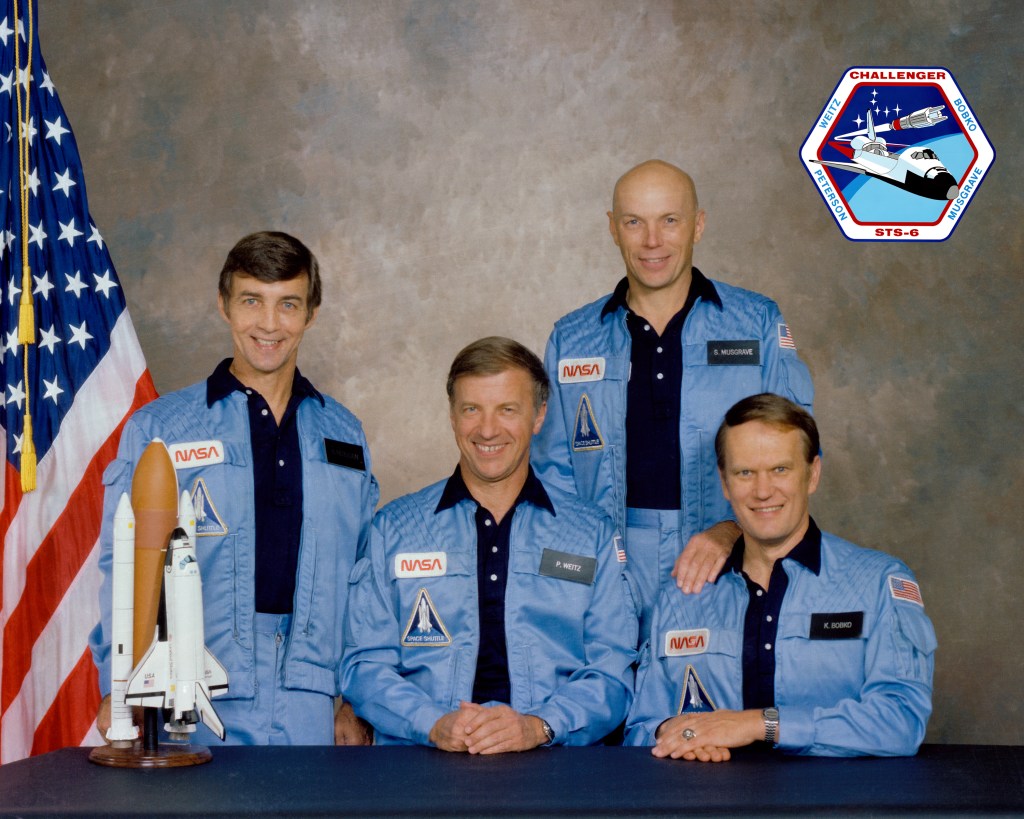STS-6 - NASA (original) (raw)
Mission Facts
Mission: Tracking and Data Relay Satellite-1 (TDRS-1)/First Shuttle Space Walk
Space Shuttle: Challenger
Launch Pad: 39A
Launched: April 4, 1983 at 1:30:00 p.m. EST
Landing Site: Edwards Air Force Base, Calif.
Landing: April 9, 1983 at 10:53:42 a.m. PST
Runway: 22
Rollout Distance: 7,244 feet
Rollout Time: 49 seconds
Revolution: 81
Mission Duration: 5 days, 0 hours, 23 minutes and 42 seconds
Returned to KSC: April 16, 1983
Orbit Altitude: 184 nautical miles
Orbit Inclination: 28.5 degrees
Miles Traveled: 2.1 million
Crew
Paul J. Weitz, Commander
Karol J. Bobko, Pilot
Donald H. Peterson, Mission Specialist
Story Musgrave, Mission Specialist
Launch Highlights
The launch set for Jan. 20 was postponed due to a hydrogen leak into the number one main engine aft compartment which was discovered during the 20-second Flight Readiness Firing (FRF) on Dec. 18, 1982. Cracks in the number one main engine were confirmed to be the cause of the leak during a second FRF performed on Jan. 25, 1983. All three main engines were removed while the shuttle was on the pad and the fuel line cracks were repaired. Main engines two and three were reinstalled following extensive failure analysis and testing. The number one main engine was replaced. An additional delay was caused by contamination to the Tracking and Data Relay Satellite- 1 (TDRS-1) during a severe storm. The launch on April 4 proceeded as scheduled.
Mission Highlights
The primary payload was the first Tracking and Data Relay Satellite-1(TDRS-1). A malfunction of the Inertial Upper Stage booster resulted in placement of the spacecraft into an improper but stable orbit. Additional propellant aboard the satellite was used over next several months to gradually place TDRS-1 into its properly circularized orbit. The first space walk of the Shuttle program performed by Astronauts Peterson and Musgrave, lasted about 4 hours and 17 minutes. Other payloads on this flight were: Continuous Flow Electrophoresis System (CFES), Monodisperse Latex Reactor (MLR), Radiation Monitoring Experiment (RME). Night/Day Optical Survey of Lightning (NOSL), and three Get Away Special canisters. This Mission used the first lightweight external tank and lightweight rocket booster casings.
The First Flight of Space Shuttle Challenger
In early 1983, with five flights of the Space Shuttle Columbia successfully completed, NASA prepared to fly its second Orbiter, Space Shuttle…

Resources
STS-6 Press Kit
Get an overview of the STS mission, its crew and activities during this mission.
Flights of Challenger
An overview of this shuttle's flights.
Retired Space Shuttle Locations
Shuttle Atlantis – Kennedy Space Center Visitor Complex Shuttle Discovery – Steven F. Udvar-Hazy Center Shuttle Endeavour – California Science…

Keep Exploring